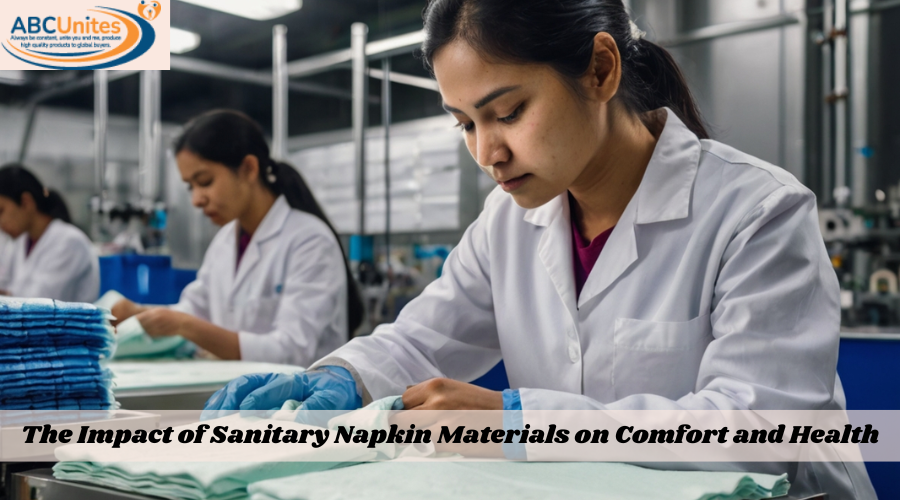
Call Us On
0086 13805968557
Address
Xilin Industrial District, Honglai Town, Quanzhou Nan 'an City, China


Aug 7,2024
The menstrual cycle is not something a woman can bear easily. It brings physical and mental stress to her, which takes lots of stamina to tolerate. Besides, hygiene problems contribute to this mental burden, which sanitary napkins can only reduce. Luckily, this hygiene product has been making lives comfortable for many women because of its high absorption and comfort level. How do manufacturers reach that level of success when manufacturing them? All the answers are mentioned below.
There is a reason behind the success of sanitary napkins in the women's hygiene industry. Multiple layers of different materials are used for the highest absorption level. After all, this is about protecting women's clothes throughout the day. Menstrual leakage is not easy to deal with, and millions of women around the world face difficulties because of it.
This is why manufacturers have to use different layers to ensure leak-proof performance, breathability, and absorption. The production process of sanitary pads primarily involves three layers: the top, middle/core, and back.
The top layer consists of nonwoven materials like PP and PE, which ensure absorption, softness, and comfort. These layers absorb the initial leakage. The fabric used for this layer is breathable, which protects the skin from rashes and allergies.
Also, hydrophobic wood pulp is used in this layer to offer maximum absorption before the liquid reaches the second layer (core) of a sanitary napkin. This top layer has to maintain enough absorption levels to reduce the load on the core. However, a core does the maximum job of absorbing liquid in a pad.
Then comes the second layer, also known as the core. This core must create a maximum barrier between the first and last layers. Manufacturers use SAP (super absorbent polymer) to make that corrosion barrier. This is a gel-type material filled inside the core. That material is similar to the one used in diapers for heavy absorption. The main activity in a sanitary pad is done in the core section. This is where the maximum liquid settles. This core is thick and more absorbent than other layers of pads.
Then comes the third or the back layer, which is there to prevent any further leakage. If the core fails to absorb excessive liquid, the third layer ensures protection. It is there to finalize the protection with nonwoven PE fabric. This material is breathable, too, which is why it prevents moisture growth.
The breathability creates comfort for the skin against rashes and allergies, just like the first layer. This one locks the liquid inside the pad to prevent any risk of leakage. As a result, the clothes remain safe from blood stains.
There are obvious reasons why suitable material is mandatory. No manufacturer wants to embarrass their consumers. These sanitary pads are supposed to protect the menstrual cycle from leakage. Every woman knows the worth of pads, and their worth is maintained by choosing efficient materials for sanitary napkins. From leakage protection to high comfort, many factors contribute to sanitary pads' success.
The comfort level depends on many elements. Leakage prevention, softness of fabric, and skin protection are the primary ones. If these factors are not followed, the purpose of wearing a sanitary pad will be over. It is not only about preventing the blood from reaching clothes but also about mental peace. The comfort in the mind and body will come once the pad fully functions. Full functionality will come if all the factors are met.
The breathability is as important as the leak prevention. If there is no breathability, the skin will get lots of problems. These problems are rashes and skin blisters, which can occur because of continuous moisture. That moisture will build up to ruin the upper layer of skin. This is dangerous for human skin, so high breathability is crucial.
If a sanitary pad company fails to notice breathability, it will fail to meet the minimum criteria of comfort. This breathability exhibits the performance level of sanitary napkins, which affects the customer experience.
Besides breathability, the softness of the fabric used in the layers of sanitary pads decides the comfort level. This means the fabric must be soft and skin-friendly to meet user satisfaction. Since women have to wear sanitary pads for hours, they need soft and silky material. Neither discomfort nor mental stress will take place then.
If low-quality material is used in any of the layers to reduce the production cost, that will affect the user experience. This factor is the primary one that makes sanitary pads preferable among users.
How flexible and fit a sanitary pad is decides how much comfort it offers. Too loose or too tight will cause discomfort for users. If the fabric used in the production is rigid, there will be a compromise on the flexibility level of the pads. That will cause discomfort and mental stress for users, which is not a good thing at all. If the pad is not fit, there will be irritation for users. Ultimately women will not prefer to use such sanitary napkins again.
Also, if it does not fit, there will be a risk of leakage from the sides. That will cause not only embarrassment but also trauma for some users. This is why it must be flexible and fit.
The summary of all the information you read above is the comfort level depends upon the material and design of the pads. All the above elements must be met if companies want to meet user needs.


Xilin Industrial District, Honglai Town, Quanzhou Nan 'an City, China
